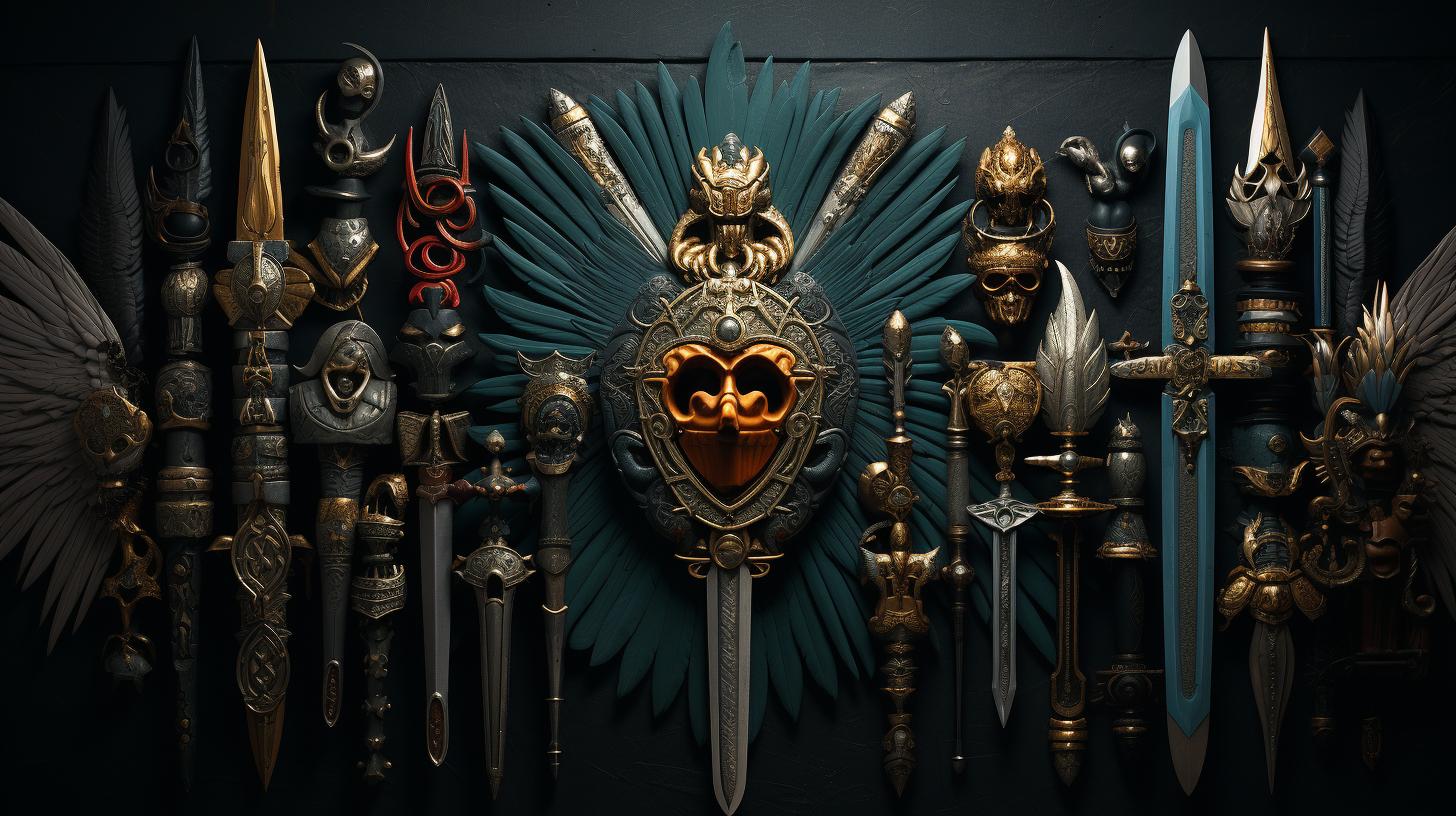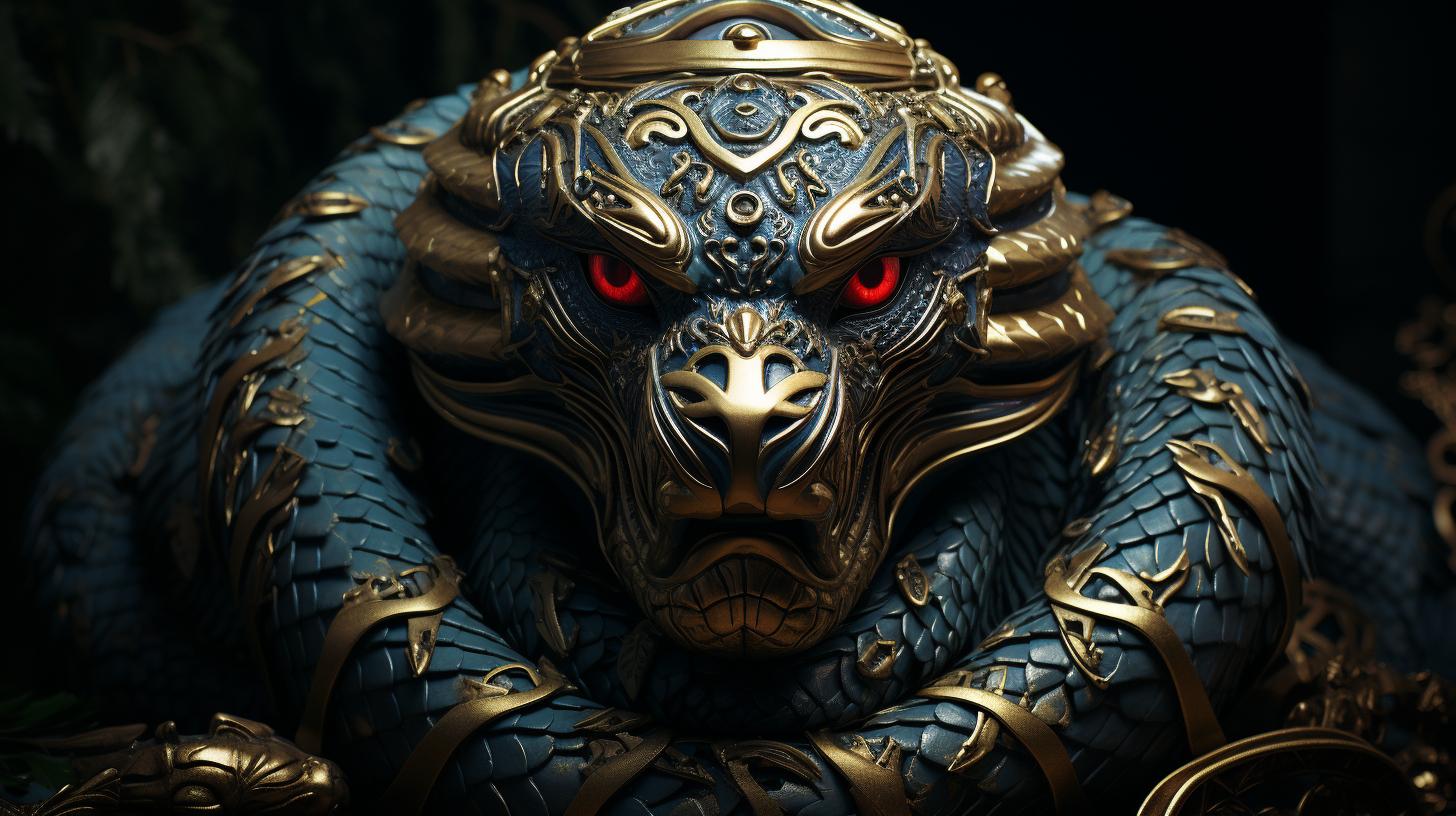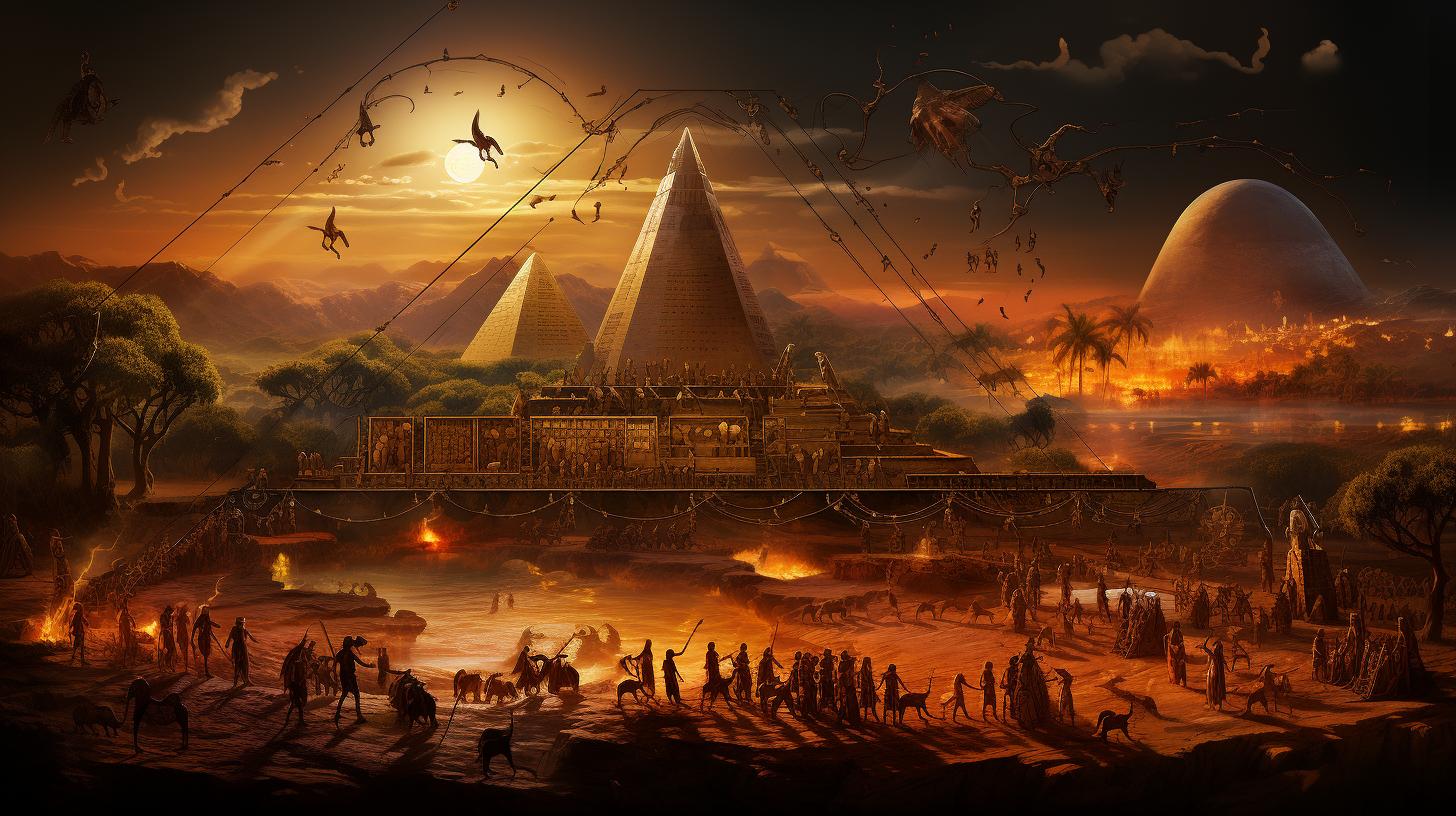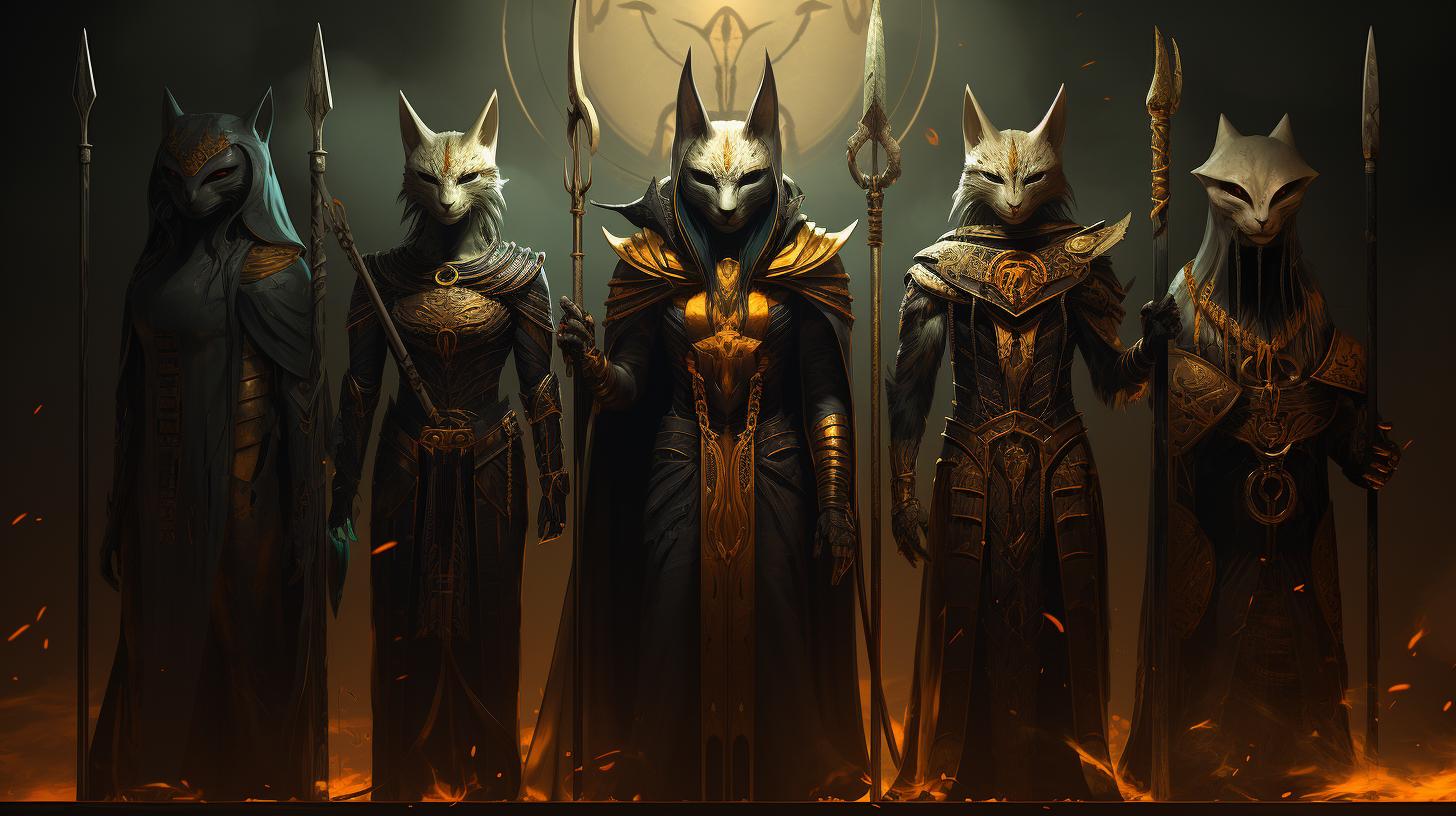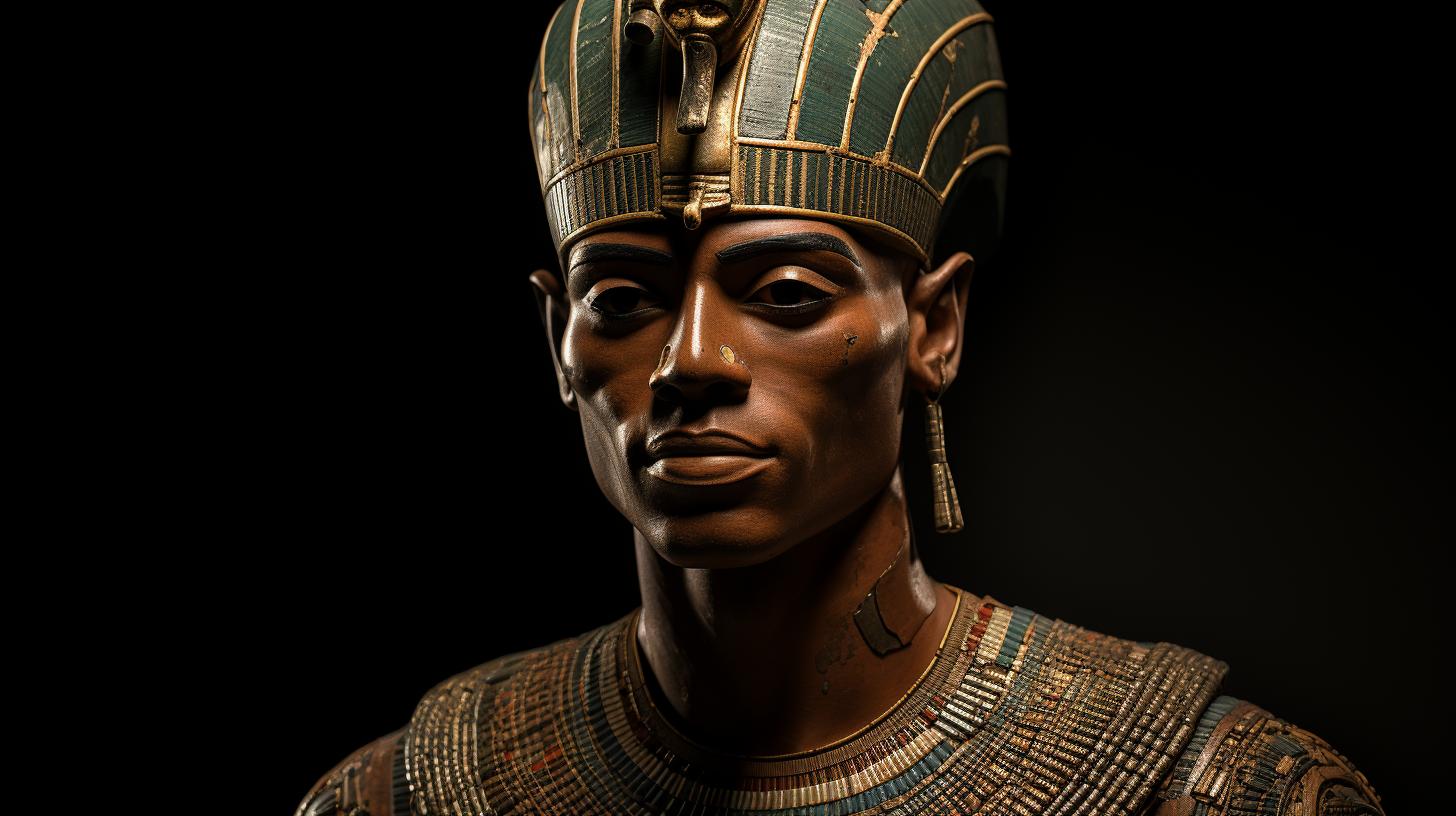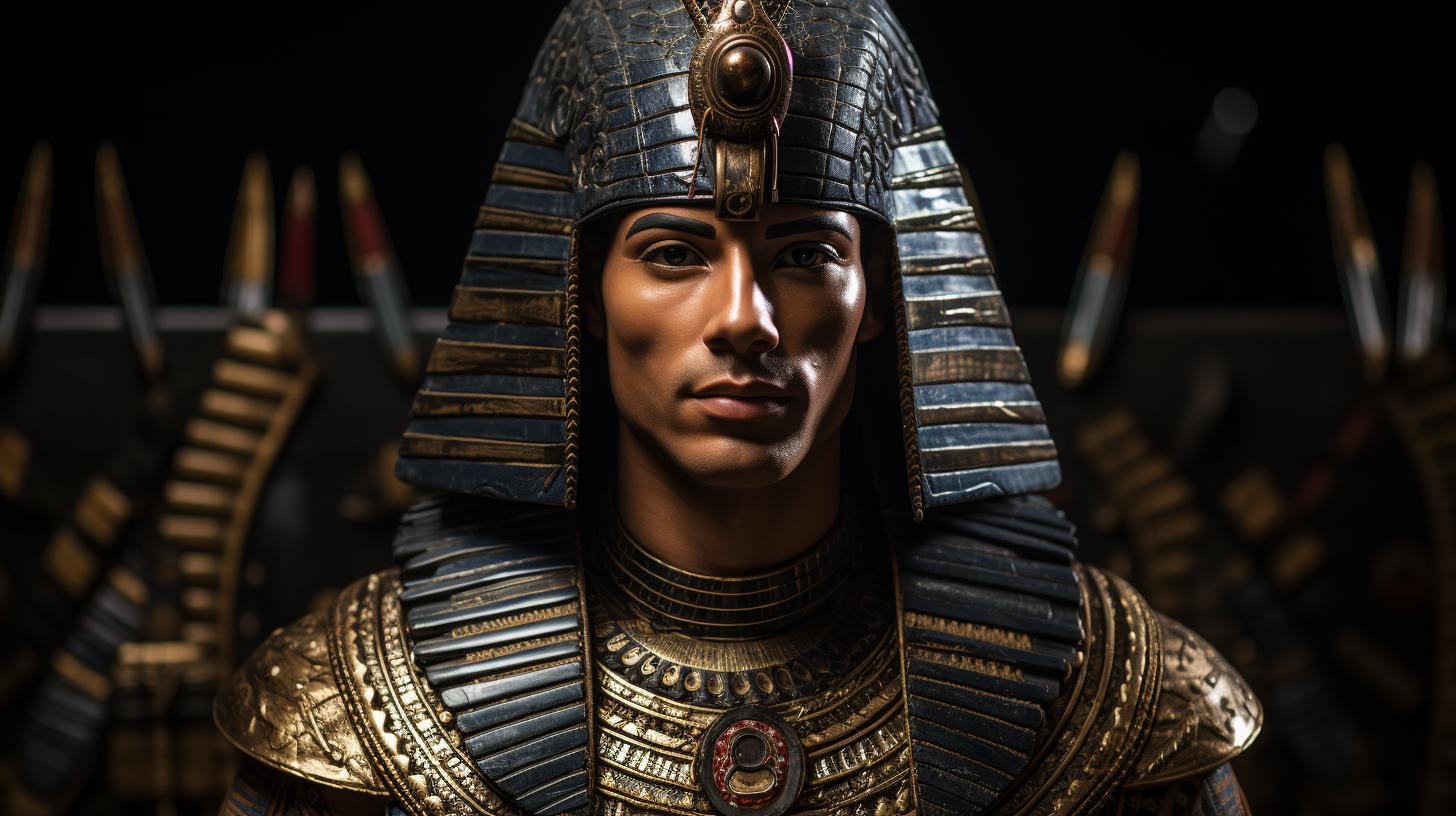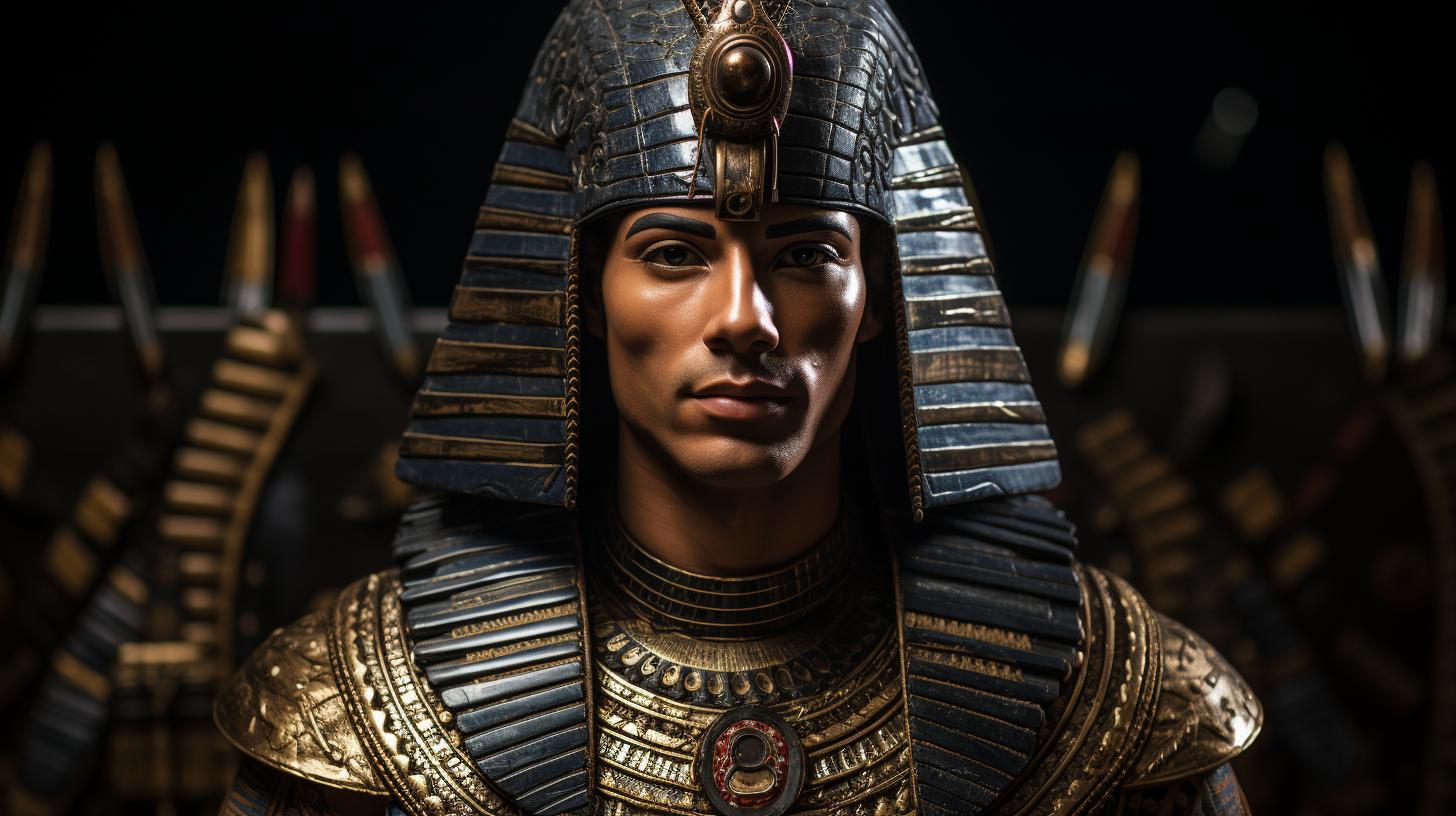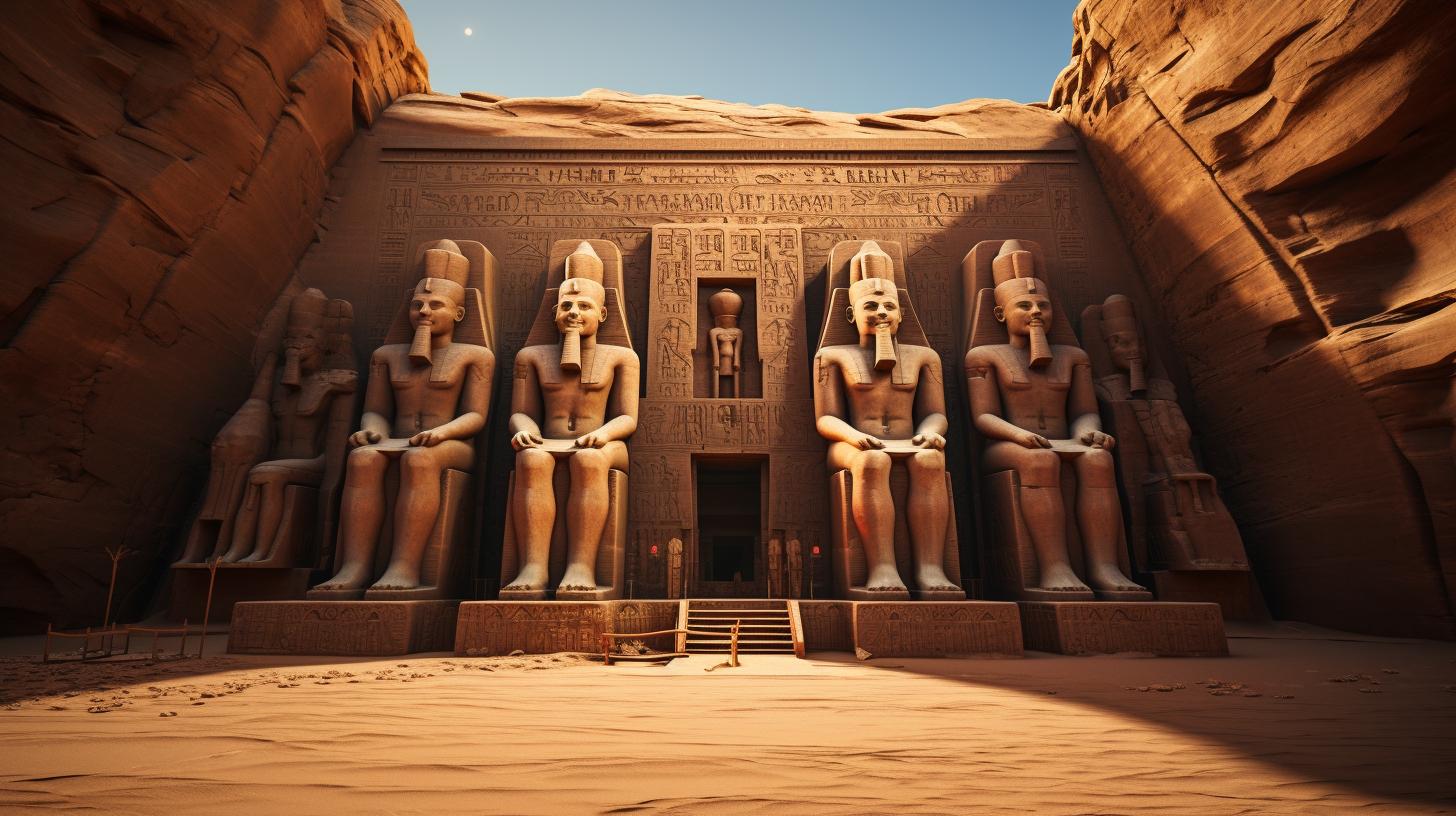Egyptian Mythology Weapons: Ancient Weapons of Power in the Land of Pharaohs
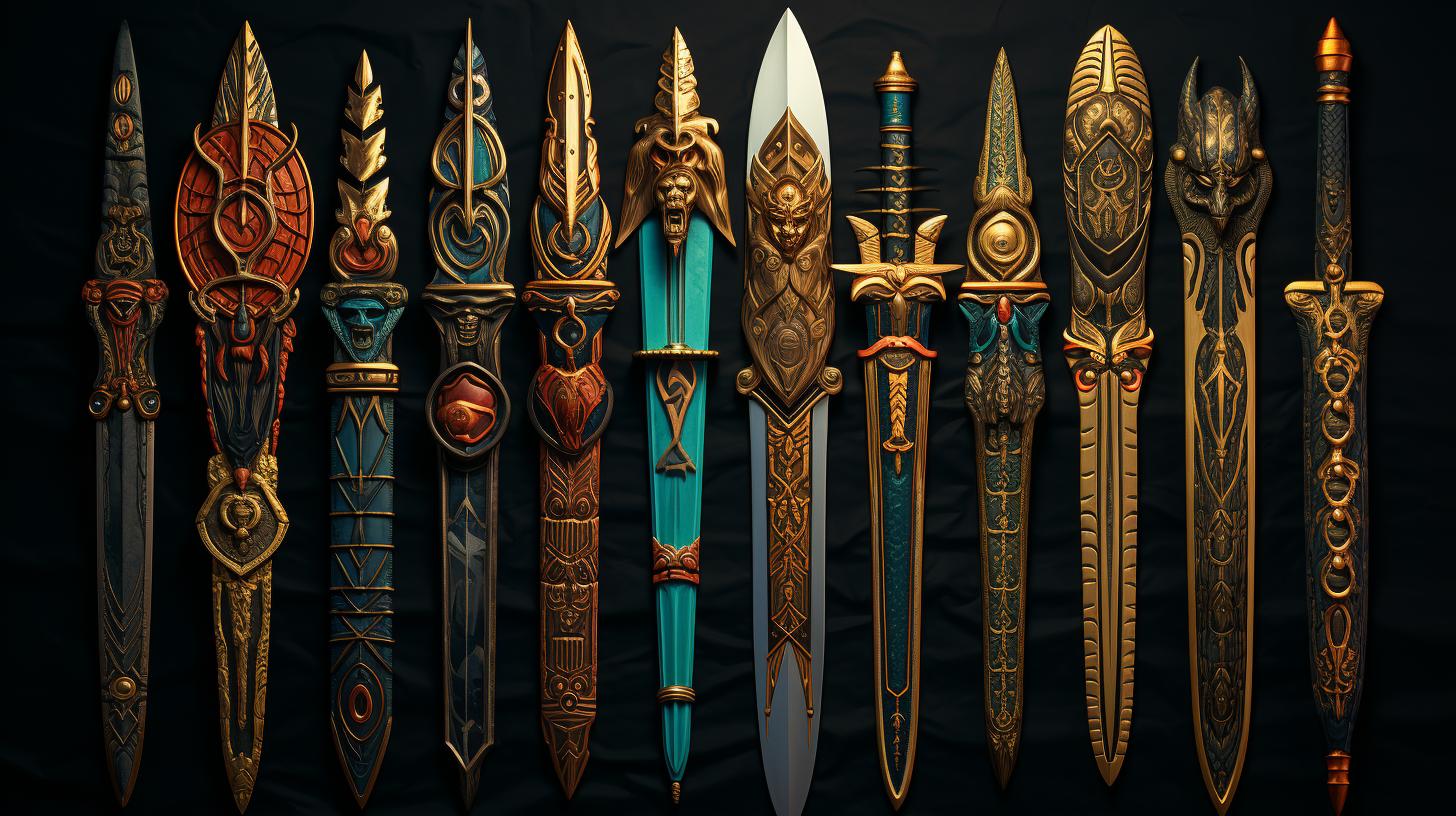
The ancient Egyptians possessed a formidable arsenal of weaponry, deeply rooted in their mythology and history. From deadly javelins to the unique Khopesh sword, they wielded a range of powerful tools.
The composite bow and swift chariots gave them an edge in battle. Additionally, the influences of foreign invaders, such as the Hyksos, shaped the development of their weapons. In this article, we will delve into the fascinating world of Egyptian mythology weapons, exploring their significance and enduring legacy.
The Mighty Javelin: A Deadly Weapon of the Ancient Egyptians
Among the various weapons utilized by the ancient Egyptians, the javelin emerged as a formidable and deadly tool in their arsenal. This versatile weapon was a spear-like projectile that played a crucial role in their military strategies.
The Egyptian javelin was carefully crafted to ensure accuracy, speed, and lethal force. It consisted of a long shaft made from sturdy wood, often tipped with a sharp bronze or iron point.
Its design allowed for quick and precise throws, making it effective for both ranged attacks and close combat.
These lethal projectiles were primarily used by the Egyptian infantry during battles. Soldiers would hurl javelins at their enemies, aiming to immobilize or incapacitate them from a distance.
The length of the javelin provided an advantage, allowing the warriors to strike at their adversaries while maintaining a safe distance.
The javelin was especially effective when facing enemy chariots or formations.
Egyptian soldiers would aim at the horses or charioteers, attempting to disrupt their movements and render the chariots ineffective. This strategic use of the javelin proved crucial in battles against foreign invaders.
Furthermore, the javelin played a significant role in hunting expeditions and sporting events, exhibiting the multi-purpose nature of this weapon in Egyptian society.
The influence of Egyptian mythology can also be seen in the use of the javelin.
The god Horus, often depicted with the head of a falcon, was associated with the javelin and considered the divine protector and patron of Egyptian warriors. This spiritual connection elevated the status of the javelin, enhancing its significance on the battlefield.
In conclusion, the mighty javelin served as a deadly weapon utilized by the ancient Egyptians. Its accuracy, piercing power, and versatility made it an integral part of their military strategies, contributing to their successes in various conflicts throughout history.
The javelin’s legacy extends beyond warfare, showcasing its cultural and mythological significance in the ancient Egyptian civilization.
Unveiling the Power of the Khopesh: A Unique Egyptian Sword
The Khopesh, a distinctively curved sword, stands as one of the most iconic weapons of ancient Egypt. Its shape, resembling the horn of a wild animal, sets it apart from the straight-edged swords found in other civilizations.
The design of the Khopesh reflects the ingenuity and strategic prowess of the Egyptians, enabling them to deliver devastating strikes in close combat.
Forged with bronze or iron, the Khopesh was a versatile weapon capable of inflicting deep, slashing wounds on opponents.
Its curved blade allowed for precise and efficient strikes, maximizing impact with each swing. Warriors wielding the Khopesh could easily hook and unbalance adversaries, giving them a distinct advantage in battle.
The Khopesh wasn’t merely a weapon, but a symbol of status and power. It often featured intricate engravings and embellishments, indicating the high-ranking individuals who brandished it. These beautifully crafted swords embodied the artistic sophistication and reverence for mythology that prevailed in ancient Egypt.
Unleashing the true potential of the Khopesh required both skill and strength. Warriors had to master the art of close-quarter combat, exploiting the weapon’s unique shape and advantage. Its effectiveness was evident in the success of Egyptian armies, as they triumphed against various foes, from neighboring tribes to formidable invaders.
The legacy of the Khopesh extends beyond its military applications. It plays a significant role in Egyptian mythology, often associated with deities and divine protectors. The mythical tales and symbology surrounding the Khopesh further enhanced its mystical allure, making it an indelible part of Egyptian culture and history.
To this day, the Khopesh continues to captivate historians, archaeologists, and enthusiasts, serving as a tangible link to the ancient world. Its unique design and rich symbolism provide valuable insights into the military strategies, craftsmanship, and belief systems of the Egyptian civilization.
- The curved Khopesh: an iconic weapon of ancient Egypt
- Deep, slashing wounds: the devastating impact of the Khopesh
- Symbol of status and power: the embellished Khopesh as a mark of distinction
- Mastering close-quarter combat: the advantage of the Khopesh in battle
- Mythical allure and cultural significance: the Khopesh in Egyptian mythology
- A tangible link to ancient Egypt: the enduring legacy of the Khopesh
Mastering the Composite Bow: The Archery Weapon of Choice
The composite bow held a prominent place in the arsenal of ancient Egyptian warriors.
Renowned for its power and accuracy, it became the weapon of choice for skilled archers who could rain down a storm of arrows upon their enemies.
What made the composite bow unique was its construction.
It consisted of layers of various materials, including wood, horn, sinew, and glue. These components were carefully laminated together to create a flexible yet sturdy bow. The combination of materials provided significant energy storage and transfer, enabling the archer to shoot arrows with greater force and over longer distances.
The composite bow’s design allowed for a longer draw length than other types of bows, granting the archer increased power and velocity. Its shape also contributed to its efficiency, as the recurved limbs stored more energy during the draw and released it rapidly upon release, propelling the arrow with incredible speed.
Archers skilled in using the composite bow played a vital role in Egyptian warfare. Positioned strategically on chariots or as foot soldiers, they could rain arrows down on the enemy from a distance, inflicting damage and weakening their opponents before engaging in close combat.
The composite bow’s effectiveness on the battlefield extended beyond its power. Its small size and lightweight construction made it highly maneuverable, allowing archers to adapt swiftly to changing situations. They could take cover behind shields or obstacles, using their mobility to their advantage.
Furthermore, the composite bow played a significant role in hunting, providing Egyptians with a means to procure food from a distance. Its accuracy and range made it a versatile weapon for both military and civilian purposes.
Overall, the mastery of the composite bow as the archery weapon of choice contributed to the success of the Egyptian army. Its power, accuracy, and versatility made it a formidable weapon in both open battles and siege warfare, solidifying the dominance of Egyptian warriors on the ancient battlegrounds.
In the Race of Chariots: Unleashing the Strength of Egyptian War Vehicles
The chariot, a hallmark of ancient Egyptian warfare, played a crucial role in shaping their military dominance. Equipped with deadly weapons and pulled by swift horses, Egyptian war chariots became symbols of power and mastery on the battlefield.
Designed with precision and craftsmanship, these war vehicles featured lightweight yet durable construction, enabling them to move swiftly across various terrains while providing stability for their occupants. The Egyptians, renowned for their engineering prowess, meticulously engineered their chariots to deliver maximum impact during combat.
Mounted on the chariots were formidable warriors armed with an array of weapons. Their primary weapon was the composite bow, an innovation that allowed for greater range and accuracy in archery.
With these bows, the charioteers could rain down a shower of deadly arrows upon their adversaries, decimating enemy ranks from a distance.
Additionally, chariots were equipped with sharp spears or javelins, enabling the warriors to strike at close quarters.
These weapons were especially effective against infantry or enemy chariot riders, causing havoc among the opposing forces.
One key advantage of Egyptian war chariots was their speed and maneuverability. Their lightweight design and skillful horsemanship allowed the charioteers to swiftly change directions during battle, outmaneuvering their opponents and launching surprise attacks.
This mobility, combined with their deadly weaponry, gave the Egyptians a significant edge on the battlefield.
It is important to note that chariot warfare required a high level of skill and coordination.
The charioteers relied on extensive training and practice to master the art of chariot riding, ensuring precise control and effective utilization of their weapons. Chariot units formed a formidable core of the Egyptian army, showcasing their military might and strategic prowess.
In conclusion, Egyptian war chariots were formidable instruments of warfare that allowed the ancient Egyptians to dominate the battlefield. The combination of swift mobility, deadly weaponry, and skilled charioteers provided them with a significant advantage over their opponents.
It was through the strength of their war vehicles that the Egyptians expanded their empire and secured their place in history.
Insights from the Hyksos: Influences of Foreign Invaders on Egyptian Weapons
During the Second Intermediate Period, known as the era of foreign humiliation, the Egyptians found themselves under the rule of the Hyksos, an invading army from Syria.
This period of occupation brought profound changes to the Egyptian weaponry, as the Hyksos introduced advanced weapons and warfare strategies.
One of the most significant influences was the introduction of swift chariots into Egyptian military tactics.
The Hyksos were renowned for their superior chariot technology, and Egyptians quickly recognized the advantages of these war vehicles. They adopted and adapted this innovation, making it an integral part of their own military forces.
Furthermore, the Hyksos brought the knowledge and craftsmanship of composite bows to Egypt. These bows were constructed by layering different materials, such as wood, horn, and sinew, creating a weapon with exceptional strength and range.
The Egyptians quickly embraced this new technology, modifying and incorporating it into their own arsenal.
The Hyksos also introduced the concept of body armor to the Egyptians. They wore protective armor made of padded linen, which was effective at mitigating the impact of various weapons.
Witnessing the effectiveness of this armor, the Egyptians began producing similar types of protection, enhancing their soldiers’ resilience in battle.
Moreover, the experience of facing the Hyksos forces in battle exposed the Egyptians to various combat strategies and tactics.
They learned the value of organized formations, proficient archery, and the use of tactics such as ambushes and surprise attacks. This knowledge shaped the way the Egyptians approached warfare and influenced their future military campaigns.
The Hyksos occupation acted as a turning point for Egyptian weaponry, instigating key shifts in military tactics, technology, and defensive strategies. The lessons learned from this period were invaluable and laid the foundation for the mighty Egyptian army that emerged during the New Kingdom.
Unraveling the Secrets of Egyptian Mythology Weapons: Expert Opinions and Analysis
The world of Egyptian mythology weapons is veiled in mystery and intrigue, captivating the imagination of historians, archaeologists, and weapon enthusiasts alike. Experts in the field have dedicated their lives to unraveling the secrets behind these ancient armaments, shedding light on their significance and impact in battle.
Upon careful analysis, experts have discovered that Egyptian mythology weapons were not merely tools of war but symbolized the religious and cultural beliefs of the ancient Egyptians. The choice of materials, intricate designs, and unique features embedded in these weapons offer valuable insights into the society that wielded them.
The expert opinions on Egyptian mythology weapons are diverse, ranging from discussions on their functional effectiveness to the symbolic representations they held. Scholars debate intricate details such as the optimal balance in the construction of the Khopesh sword or the range and accuracy of the composite bow.
While some experts focus on the craftsmanship and technical aspects of these weapons, others delve into the realm of mythology and spiritual significance. They explore the connection between these weapons and the deities worshipped in ancient Egypt, examining how each weapon embodied the power and traits associated with a specific god or goddess.
- Dr. Sarah Johnson, a renowned archaeologist, suggests that the Khopesh sword, with its distinctive curved blade, may have been a symbolic representation of the falcon-headed god Horus, known for his fierce and protective nature.
- Professor Michael Stevens, an expert in ancient weaponry, argues that the composite bow, with its ability to shoot farther and with greater force, played a pivotal role in shaping Egyptian military strategies, allowing them to dominate both on the battlefield and in foreign campaigns.
- Noted historian Dr Emily Thompson proposes that the mace-axe, with its unique design, embodied the strength and authority of the pharaohs, serving as a potent symbol of both milita y might and divine kingship.
These expert opinions and analyses collectively contribute to a deeper understanding of Egyptian mythology weapons, uncovering layers beyond their physical attributes.
They shed light on the cultural, religious, and military significance of these weapons, bringing us closer to comprehending the intricate tapestry of ancient Egyptian warfare and mythology.











